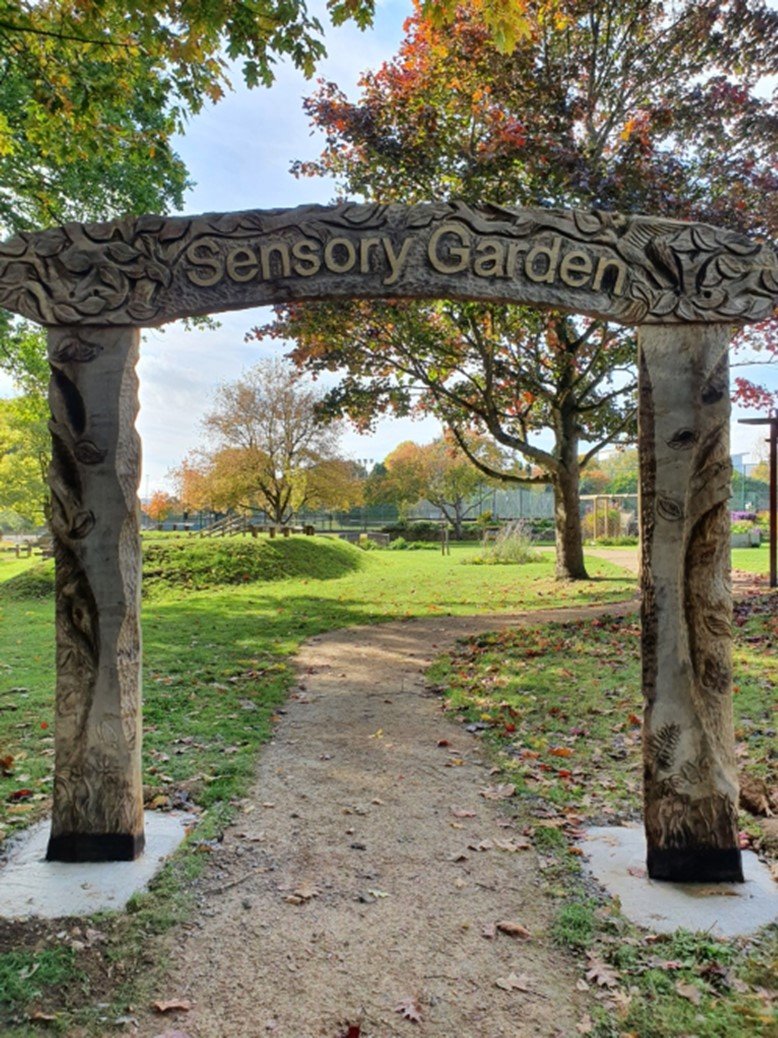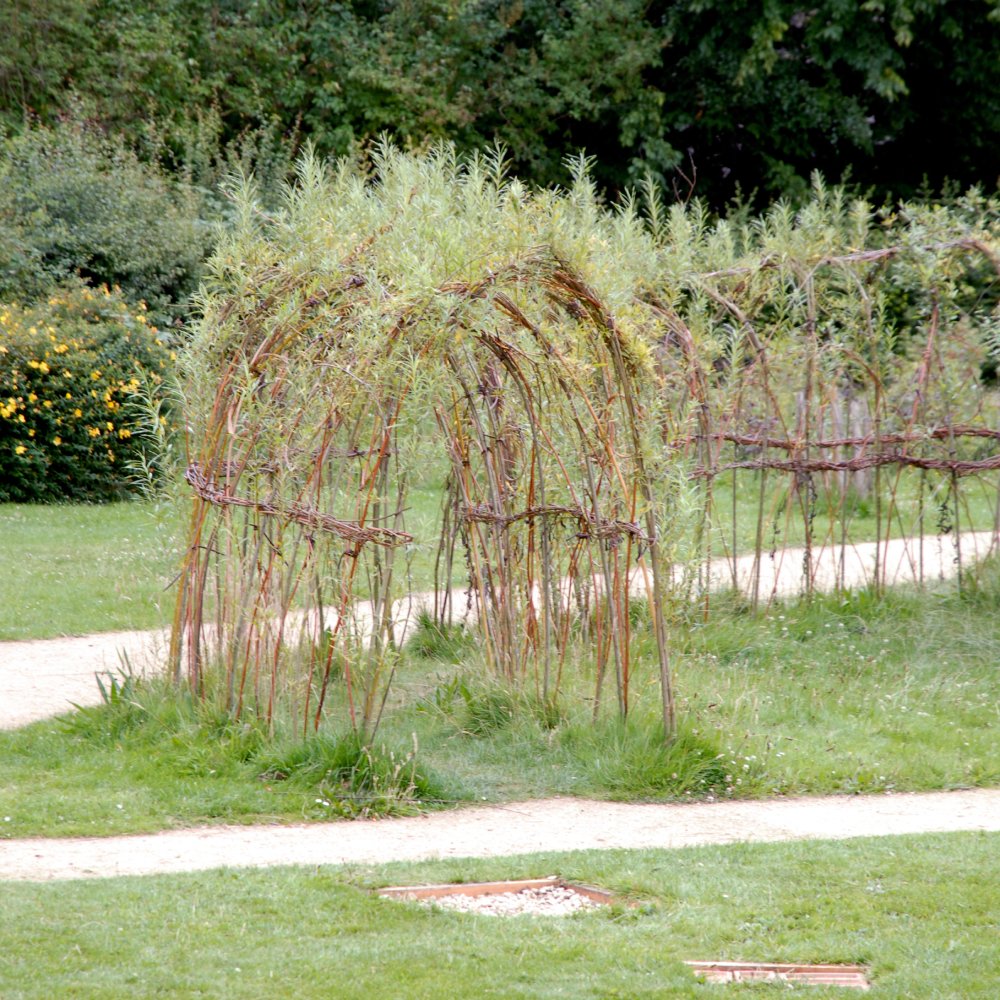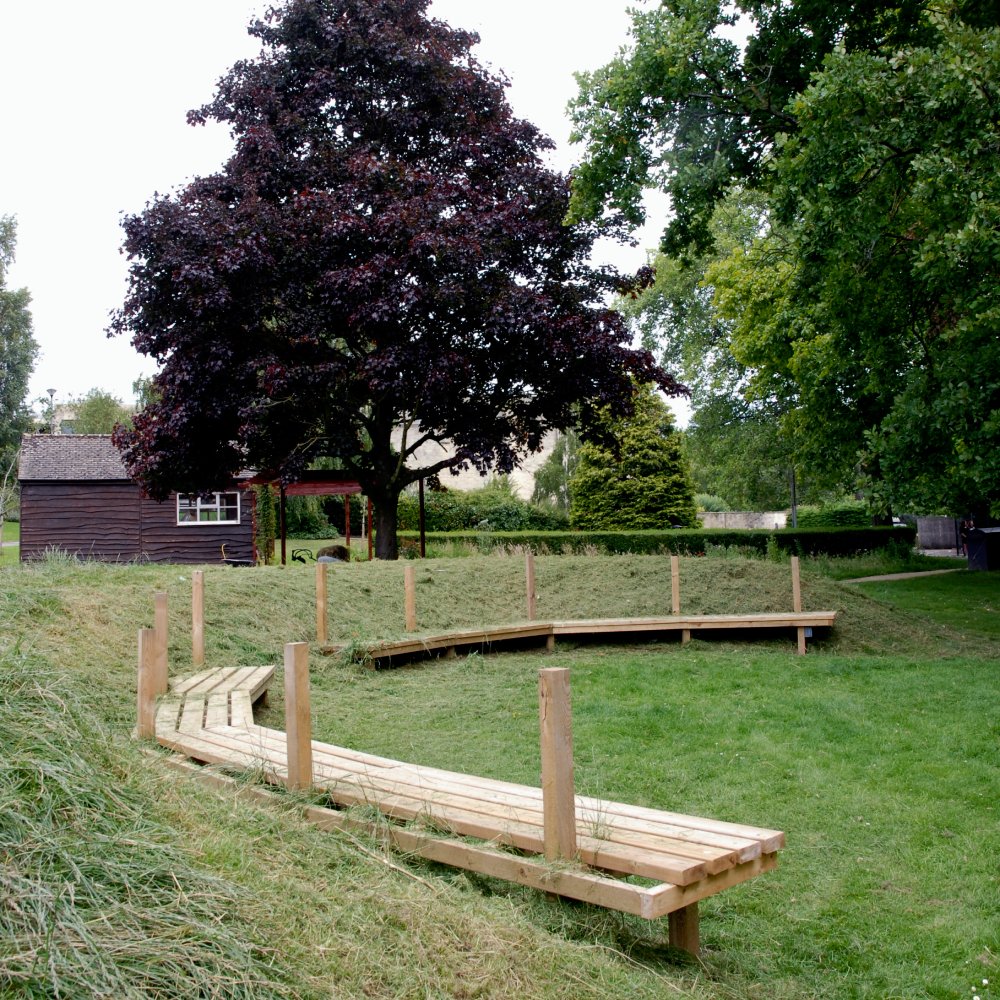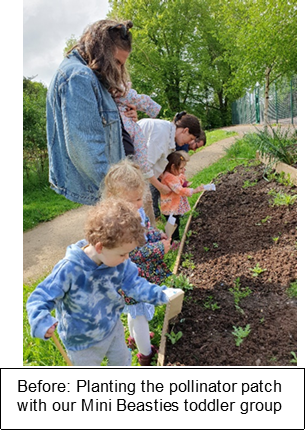Stratford Park’s Sensory Garden
Autumn 2023 We have some amazing news to share:
The National Lottery Community Fund is going to fund our much-loved Sensory Garden in Stratford Park for two more years!
It’s been a long journey since we sat down with Creative Sustainability and Daisy Bank Garden Design to work out how best to meld community engagement and garden planning to transform the former putting green. For this people-powered project which has developed over seven years, we worked with Stroud District Council and Stratford Park Maintenance team and we’ve had funding from Stroud District Council, the People’s Postcode Lottery and The National Lottery Community Fund in that time. Thanks to #NationalLottery players, this community gem will continue to improve and develop with the loving care of our dedicated volunteers. We’re delighted that we can continue to work with wonderful community groups including Sunflowers Suicide Support, BarBar Nursery and our own Creative Shed team, as well as new gardeners Thomas Keble School and Selsley Cubs.
We spoke to people using the space during the summer, and the love they shared for our Sensory Garden was truly humbling. We're so proud of the work our community has done here, and we're hugely grateful to the National Lottery Community Fund for seeing its value and continuing to fund it for the people of Stroud – and for visitors, too.
Sensory progress by Richard Lewis
Our work at the Sensory Garden Project at Stratford Park has continued over the Summer and Autumn with the group being involved in several projects on-site.
As part of our work at this beautifully kept area in the park, some volunteers have been maintaining the hedgerows, labyrinth and borders keeping the space looking tidy and well kept for visitors to enjoy.
Another task is the refurbishment of the large pergola built on the patio area adjacent to the ‘old ice cream shed’. The pergola, both weathered and vandalised in places, has now been refurbished with new cross beams on joists; see this picture of revamp in progress. Over the next few weeks, the pergola will be rough-sanded down and then painted in a light-coloured wood preserve giving the structure a well-needed spring clean which we hope will make it last for another five to ten years.
As Tamsin explains below, we’ve been using a QR code to get feedback from people who visit the garden, and several people suggested enlarging the Barefoot Trail area.
This picture shows volunteers constructing one of the dozen new wooden frames that will be installed on that trail.
A cherished community garden by Tamsin Bent
As Richard has explained, it’s been all happening in the Sensory Garden. We’ve had new community groups join and existing groups going from strength to strength.
Over the summer we carried out some evaluation of our work for our funders and received some wonderful feedback. Thank you to everyone who took part.
Here are just a couple of responses:
“Very accessible – my daughter drives a powered wheelchair. She likes to meet her friends here, finding it a very calm place. Thank you.”
“We are a local childminder group and we love to visit the Sensory Garden for these sensory experiences and much more. My children of all ages (0-7 years old) enjoy exploring each part and we use it as an outside learning opportunity. We all love the outdoors so it is a perfect place to visit. We probably visit at least twice a month and spend a long time there. It’s amazing!”
We’re now looking for volunteers to come and help look after the plants, so if you’re a keen gardener and have some time on your hands, we’d love to hear from you: tamsin@stroudvalleysproject.org
Spring 2023: Art in the Sensory Garden by Richard Lewis
Over the autumn and winter months, the Sensory Garden Project’s Wednesday group spent time harvesting Hazel from Stratford Park’s woodlands and hedgerows to create natural fences and boundaries.
As the photographs show, the volunteers have again spent time producing organically made art.
I say ‘art’ as it is exactly that; from the start of the process selecting Hazel for both the stakes and bindings that tie in along the top and middle of the fence giving strength and structure, to production of uniformed lengths of stakes and bindings for the building of the fences.
It is great that all the Hazel needed for the work was sourced from within the park and also with some of the Hazel harvested from SVP’s 2013/14 Big Tree
Plant project.
Also, by building these boundaries in and around the Sensory Garden space, we hope to encourage and guide people visiting the space. The building of one fence around the wildlife grassland area will allow that seeded space to germinate and grow while discouraging people from trampling on the area.
Over the next few months from spring into summer, the group will continue our work on maintaining already created areas as well as constructing a terraced area earmarked for more pollinator flower beds.
Autumn 2022: A garden for all by Tamsin Bent and Richard Lewis
If you visit the Sensory Garden at Stroud’s Stratford Park, you will see all sorts of interesting beds and other elements designed and/or looked after by different community groups. And this year we’ve had new gardens joining those developed by Emerging Futures, Stroud and Cotswolds Alternative Provision School, BarBar’s Nursery, Stroud Third Brownies, and Sunflower Suicide Support.
In the early spring, we planted up the first new area: our garden for people with visual impairments, followed by our Pollinator Patch designed and created with gardeners Muck and Magic, and also South Gloucester and Stroud (SGS) College’s herb bed with steps.
Our Wednesday team was involved in the creation of the SGS College area and another for Hearts for Heroes, a charity that supports families of children living with congenital heart disease and heart problems. Along with the new work comes the time-consuming task of maintaining the large spaces and borders for the enjoyment of visitors.
The long-drawn-out work of repointing stone steps, patios and walls has also taken time – and these tasks really need dry days!
The group has recently been helping contractors install a large wooden arch carved by chainsaw artist Denius Parson to mark the garden’s entrance. We also plan to build a hazel fence around the native wildflower area, with hazel stakes and heatherings (bindings) harvested from trees planted in the park during 2013 by us as part of the Big Tree plant funding.
So if you’re walking through Stratford Park and have five minutes to spare, take a wander or have a sit down in our wonderful community Sensory Garden.
Previously
Creating a new Sensory Garden in Stratford Park
We have been working with our team of volunteers to transform the former pitch and putt site into a sensory garden and community space. The garden is being designed to provide a multi-sensory experience, with an array of sounds, sights and textures, as well as an amphitheatre built from scratch by our great team.
Creating a wheelchair-friendly garden zone
The Wednesday group here embarked on the work of planning then building an area within the Sensory Garden that people with impaired vision will hopefully be able to enjoy. The design for the space consisted of a flat patio area surrounded by five large, raised beds that are to be at ‘hip’ height and wheelchair friendly. This will allow both visually impaired people and wheelchair users the opportunity to enjoy the planting schemes.
As with the creation of the amphitheatre, the design and build has once again tested the skills and knowledge of both the project officer and the volunteers. The building of this area has needed good quality of work and you can see this has happened when visiting the site. The volunteers involved have taken great pride in the remarkable results they’ve achieved, and rightly so.
Some history of the project
Phase 1 – dry stone wall and amphitheatre
We were asked to build a dry stone wall that is very ‘front of house’ for the public to see, which was quite a challenge for all involved, especially as some volunteers had no experience of walling. But everyone mucked in – literally! – learning to use a cement mixer for the Cotswold stone capping for the top of the wall. The work by our volunteers was of a really good standard and looks great. Everyone that took part in that bit of the project gained lots of new skills – see photo of walling being finished.
Once the dry stone wall was finished, planting up was done in areas of the newly-created bank.
The building of the amphitheatre really tested all of us, from the initial pencil drawings put together at the beginning of January 2020, right through to the end. But working at a steady pace, the group enjoyed and endured sun and rain, and completed the magnificent wooden seating area.
Along with general maintenance of the garden area flowerbeds and borders, work then started on the final phase of seating to top the amphitheatre. We built five long low-level seats made from Cedar of Lebanon and oak – timber felled or windblown from the park.
Phase 2 – building disabled footpaths
Path building
Phase 2 of the project was to map out and create the main disabled access paths through the sensory garden areas. The group set and fixed the footpath edging – an interesting task when fixing and bending metal edging!
The top dressing for the main footpath through the garden, a fine bonding aggregate with Type 1 crushed stone underneath, was put down using a whacker plate (a mechanical vibrating plate that compresses down the aggregate) on each layer, enabling wheelchair-bound and other members of the public to explore the sinuous pathways through the main sensory garden area. Electricity and water supplies were also fitted during this phase of the project, to supply water and a power source for a number of sensory features that will be created in the final Phase 3.
Other projects
The volunteer teams were also involved in several projects onsite. These included a new design and build of Little Owl boxes, the creation of a large raised bed made from a Cedar of Lebanon tree (Cedrus libani) that had fallen in the park (to be used as a nursery and temporary home for hedgerow species) and increasing seating areas for the public by installing three oak benches and a hexagonal tree seat.
We went on to complete a further section of footpath adjacent to the small child play area. We were able to propagate Devil’s-bit scabious (thanks Sara G) for a Butterfly Conservation Trust project in the Stroud district, and made use of upcycled garden tools donated to us via our own eco shop.
Completion of the pergola build went well under the watchful eye of Mike McCrea, idverde UK Contract Manager at the park. Once finished, climbing roses were planted, giving shade, scent and colour to another area of the garden.
Then we set about extending the patio area, and to add more colour, planted and guarded blossom and fruit, including six different types of Gloucestershire apple varieties, along one side of the main footpath.
Thank you
A big THANK YOU to all the volunteers involved in this part of the project. If it hadn’t been for their interest and commitment in the project, we would not have met the deadlines so far.
Another big THANK YOU must go to Mike McCrea and his idverde UK team (Paul, Shaun and Andy), for their support and guidance through the different aspects of the project. The work being achieved by all involved puts down a really good ‘marker’, so to speak, as the working relationship between Mike’s team and our staff and volunteers is excellent – even during some testing times in the early phases of the project. Due to the standard of work that our volunteers achieve, the group which worked alongside the idverde UK team hope to be tasked with further projects around the leisure centre parks and gardens.


















